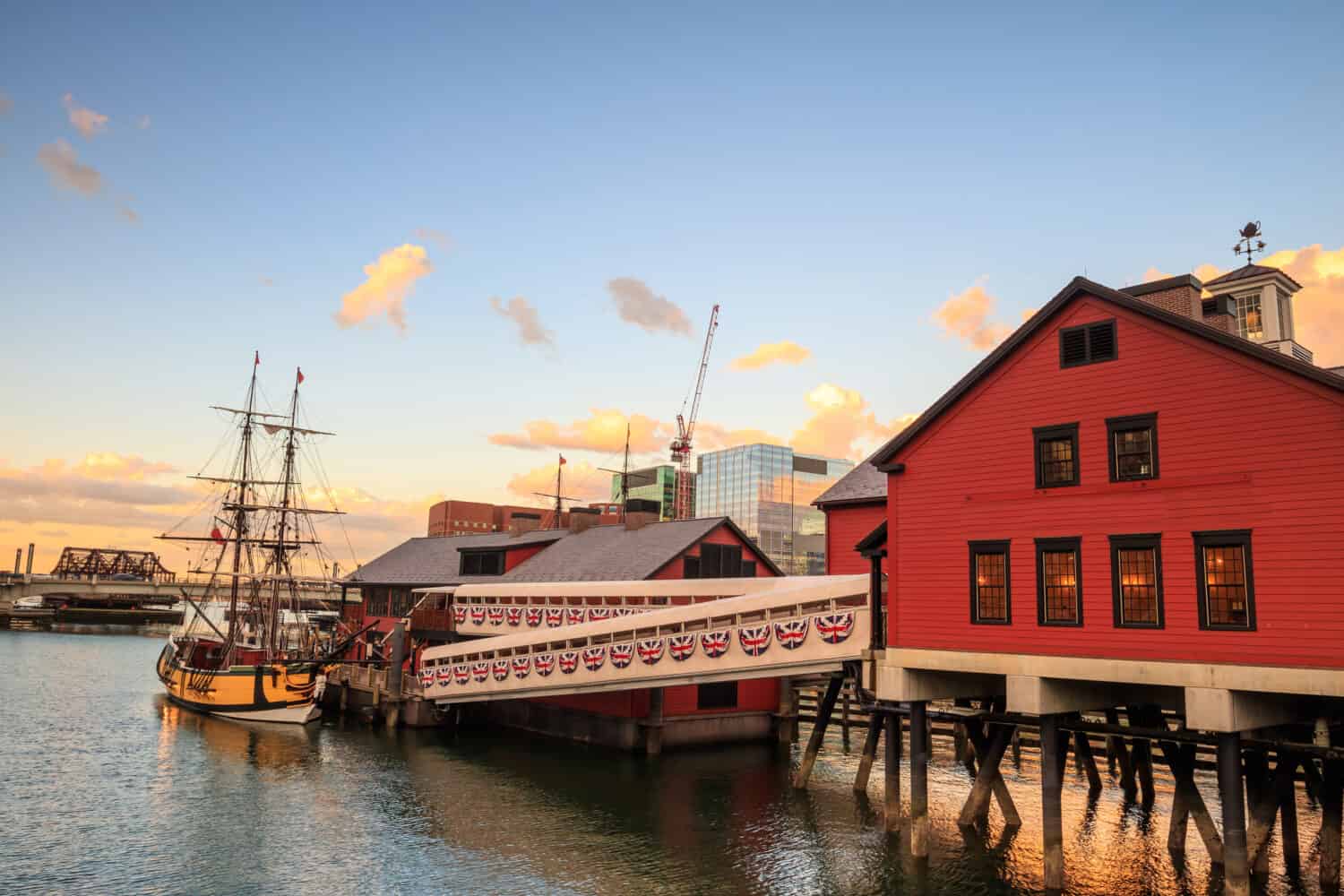Boston Harbor is a large and historically significant harbor in Massachusetts Bay. On average, Boston Harbor is less than 20 feet deep. Since it is relatively shallow, the harbor has to be regularly dredged so that large ships can navigate it. The main channel that large container ships use is dredged to 47 feet deep.
Boston Harbor is home to the Port of Boston, the oldest active port in the United States. The Port of Boston is one of the most essential ports in American history. This article discusses the history and ecology of Boston Harbor, along with common recreational activities enjoyed there.

Despite its importance as a port, the Boston Harbor is not very deep.
©Travellaggio/Shutterstock.com
The Founding of Boston
Boston is an economic and cultural center of the New England region of the United States. It is also one of the oldest towns in the United States. William Blaxton, a cleric from Lincolnshire, England, became the first European settler in the region in 1623. The town of Boston was later founded in 1630 by settlers who arrived from Boston, England. Prior to European colonization, the area that became Boston was inhabited by the Massachusett Native American people.
The native name ‘Massachuseuck‘ means ‘at the great hill’, referring to the Great Blue Hill 10 miles south of Boston. The Massachusett people were devastated by diseases brought over from Europe by settlers. There are very few written records of the Massachusett people, and no federally or state-recognized tribe exists for them. However, Massachusett people today keep their history alive through oral tradition.
After its founding, Boston quickly grew into a large and important city in the colonies. Boston was the largest city in the Thirteen Colonies until the mid-18th century. The city was an important location during the American Revolution from 1765 to 1791. The Boston Massacre and the Boston Tea Party are two of the most significant events that took place during the American Revolution. After the United States gained independence from England in 1776, Boston continued to grow. Boston’s population grew significantly in the 19th century. Today, the population of Boston is 675,647 according to the United States Census.

The Boston Harbor is an important location for commerce and recreation in the city of Boston.
©Richard Cavalleri/Shutterstock.com
History of the Boston Harbor
Boston Harbor has a rich history and played a key role in Boston’s growth into a major city. The harbor is an ideal port location because the waters are relatively deep, and it is protected from the Atlantic Ocean by islands. Settlers began building the seaport when they arrived in the 1630s. The original location of the port is Long Wharf. Today, the main cargo locations of the Port of Boston are in the Charleston, East Boston, and South Boston neighborhoods.
The Boston Tea Party of 1773 was a protest against the Tea Act of 1773, which allowed the British East India Company to sell tea in the colonies without paying taxes. This gave the East India Company a monopoly since they could sell their tea at a much lower price and drive out colonial merchants.
In protest, the Sons of Liberty, a political organization including members such as Samuel Adams and Paul Revere, led the Boston Tea Party. The Sons of Liberty threw chests of tea belonging to the British East India Company into the Boston Harbor. This protest, and the harsh response of England, ultimately escalated into the American Revolution.
Ecology of the Boston Harbor
The Boston Harbor contains a rich diversity of ecosystems. Salt marshes, tidal mudflats, and rocky shores are some of the important ecosystems of the Boston Harbor area. Many species of marine birds, mammals, crustaceans, shellfish, and fish live in and around the harbor. Harp seals visit New England during the winter, and sometimes come into the Boston Harbor. Harbor porpoises also visit the harbor regularly. The piping plover, an endangered shorebird, nests in and around the harbor.

Piping plovers build their nests in the sand and gravel at beaches.
©Jay Gao/Shutterstock.com
Boston Harbor has a long history of use as a waste dump, and as a result, it has a historical problem with pollution. However, in 1985, the Massachusetts Water Resources Authority was created to reduce pollution in the harbor by constructing waste processing plants. This project is known as the Boston Harbor Cleanup and is regarded as a huge success.
What to Do on the Boston Harbor
The Boston Harbor is a popular place for boating, fishing, camping, and learning about the area’s history. The Boston Harbor Islands National Recreation Area is a protected area that offers hikes, camping, and education programs. Additionally, the Tea Party Ships and Museum is on the Boston Harbor, and people can visit to learn about the Boston Tea Party and the American Revolution.

The Tea Party Ships and Museum in Boston Harbor performs re-enactments of the Boston Tea Party.
©f11photo/Shutterstock.com
Where is the Boston Harbor Located on a Map?
Boston Harbor is adjacent to the city of Boston, at the mouth of the Charles River. Boston is in Eastern Massachusetts, on the Atlantic coast.
Here is the Boston Harbor on a map:
The photo featured at the top of this post is © Richard Cavalleri/Shutterstock.com
Thank you for reading! Have some feedback for us? Contact the AZ Animals editorial team.






